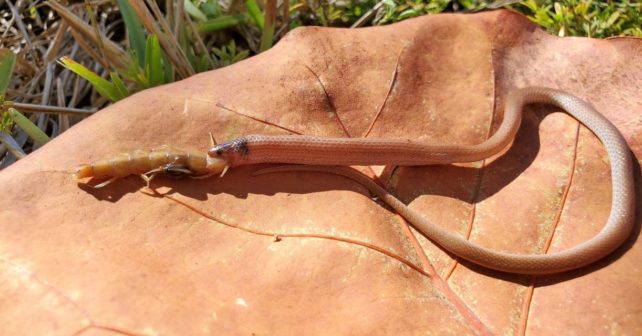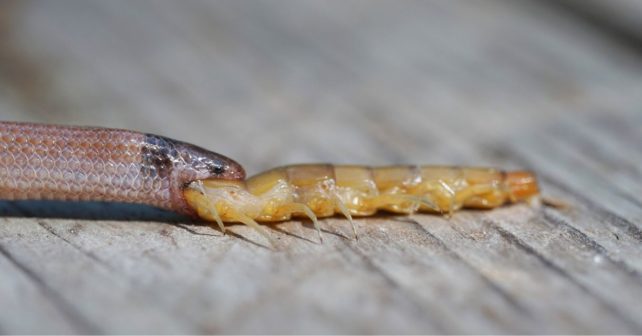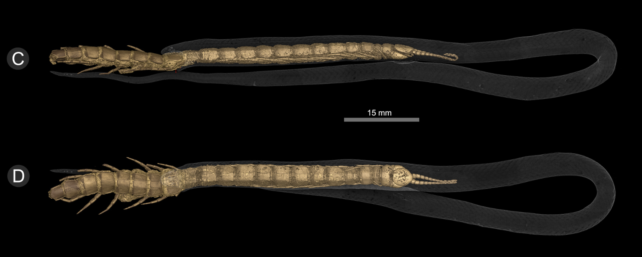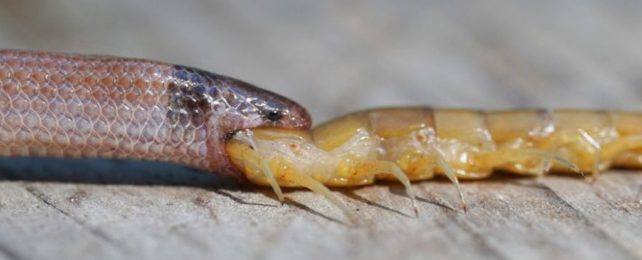The rim rock crowned snake is said to be the rarest legless slitherer in North America.
Not only does this small snake spend most of its life underground, hiding in crevices or burrowing beneath rocks, only about 26 individuals are known to exist. These survivors are confined to what's left of southern Florida's pine rocklands and hardwood hammocks.
Until recently, no one even knew what the elusive rim rock crowned snake (Tantilla oolitica) ate, despite being first described in 1966. In fact, no one has seen head or tail of it, alive or dead, since 2018
This February, that dry spell came to an end. A visitor to John Pennekamp Coral Reef State Park stumbled upon a dead rim rock crowned snake while walking along a trail on Key Largo.
Even more incredible, the snake's corpse was frozen in time, suffocating on the body of a giant centipede.

"I was amazed when I first saw the photos," says Coleman Sheehy, the Florida Museum's herpetology collection manager, where the specimen is now kept.
"It's extremely rare to find specimens that died while eating prey, and given how rare this species is, I would never have predicted finding something like this. We were all totally flabbergasted."
Other types of crowned snakes also eat giant centipedes and other potentially dangerous prey, including scorpions, but this is the first food record of any kind for this particular species.
The lifeless individual found in Key Largo was just over 20 centimeters in length (8 inches), and even though the Caribbean giant centipede (Scolopendra alternans) it was trying to swallow was a juvenile, the predator had eyes much bigger than its throat.
Only about 50 millimeters (2 inches) of the snake's meal got down its gullet before it choked to death; there was still another 23 millimeters of centipede to go.

"We were able to perform a digital autopsy, which allowed us to examine the centipede and snake, including its injuries and gut contents, without ever picking up a scalpel," explains Jaimi Gray, an evolutionary morphologist museum.
Gray and her colleagues suspect asphyxiation is what ultimately killed the snake.
CT scans – the first to be performed on the species – show that predator's trachea was pinched at precisely the place where the centipede was widest. The girth is what probably cut off the individual's air supply.
Envenoming was another possibility the researchers considered.
A wound from the centipede's venomous pincers was found on the predator, but apart from a bit of internal bleeding, the centipede's pincers appear to have done little other damage to the snake.
The snake had likely evolved some level of resistance to its prey's venom, as other snake species inclined to gorge themselves on giant centipedes have.

Since 1975, the state of Florida has listed the rim rock crowned snake as threatened, and on the mainland, the species is especially endangered.
Urban sprawl stretching from West Palm Beach to Miami has left only 2 percent of the snake's pine rockland habitat intact outside of the Everglades.
No one has seen the snake in this region for many years. Key Largo may be one of the last havens left for herpetologists to study.
"We can't say for sure whether or not they're still present in peninsular Florida. Absence of evidence is not evidence of absence, but their habitat has basically been destroyed," Sheehy says.
Scientists are hopeful the findings will allow us to better understand the species' anatomy and diet as it teeters on the brink of extinction.
In 2007, the rim rock crowned snake was listed as endangered by the International Union for Conservation of Nature. It has yet to receive a federal conservation status in the United States.
The study was published in Ecology.
